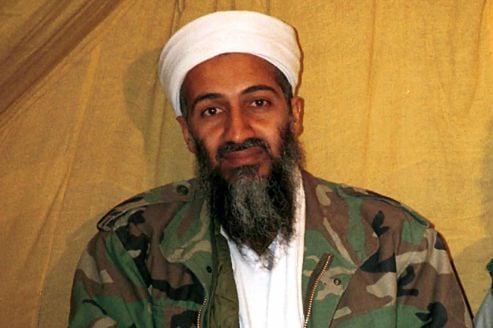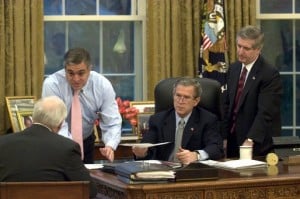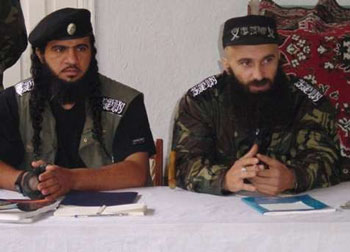9/11 Analysis: “Who Is Osama Bin Laden?”

In the course of the month of September, Global Research will be featuring a selection of articles by prominent authors, which indelibly reveal the lies and fabrications underlying the official 9/11 story.
The following article entitled “Who is Osama bin Laden by Michel Chossudovsky was first published on September 12, 2001
***
.
Author’s Note
It was 23 years ago: I started writing on the evening of September 11, 2001, late into the night, going through piles of research notes, which I had previously collected on the history of Al Qaeda. This first text on 9/11 entitled “Who is Osama bin Laden?” was completed and first published on September 12, 2001.
From the very outset, I questioned the official story, which described nineteen Al Qaeda sponsored hijackers involved in a highly sophisticated and organized operation.
Something was not quite right: Al Qaeda was a creation of the CIA. Osama bin Laden had been recruited by the CIA. Yet barely a few hours after the attacks, CIA Director George Tenet was pointing his finger at Al Qaeda.
My first objective was to reveal the true nature of this illusive “Enemy of America”, who was “threatening the Homeland”.
Afghanistan was identified as a “state sponsor of terror”. The 9/11 attacks were categorized as an act of war, an attack on America by a foreign power.
The right to self-defense was put forth. The US-NATO aggressor was portrayed as the victim.
On September 12, 2001, less than 24 hours after the attacks, at a meeting of the Atlantic Council in Brussels, NATO invoked for the first time in its history “Article 5 of the Washington Treaty – its collective defence clause” declaring the 9/11 attacks on the World Trade Center (WTC) and the Pentagon “to be an attack against all NATO members.”
The tragic death of thousands of Americans on 9/11 allegedly instrumented by Al Qaeda (with the support of an unnamed foreign power) was used as a pretext and a justification for launching the first phase of the Middle East Central Asian War, which consisted in the bombing and occupation of Afghanistan.
This invasion of Afghanistan launched four weeks later on October 7, 2001 was heralded as “A Just War”. The media was complicit.
Military analysts failed to mention that the planning of a major theater war thousands of miles away would require several months of preparation and coordination. (You cannot do it in 28 days!)
September 11, 2001 marked the onslaught of the “Global War on Terrorism” (GWOT) which was heralded by the media as a humanitarian endeavour.
This was achieved by sustaining the myth that Muslim terrorists supported by the Taliban had attacked the WTC and the Pentagon on September 11, 2001. The evidence –including the subsequent studies on controlled demolition–have confirmed that this was an outright lie.
The concluding paragraph of my September 12, 2001 article states the following:
‘In the wake of the terrorist attacks in New York and Washington, the truth must prevail to prevent the Bush Adminstration together with its NATO partners from embarking upon a military adventure which threatens the future of humanity.”
Global Research was launched on September 9, 2001, two days before 9/11. My article on Bin Laden was among the first articles featured on our website.
Ironically, it was not the object of censorship. It was ranked by Google as one of the most widely read articles on Osama bin Laden.
(No changes or edits to the original September 12, 2001 text have been made, images added)
Michel Chossudovsky, Global Research, September 8, 2022
***
Who Is Osama Bin Laden?
by
Michel Chossudovsky
Global Research, September 12, 2001
A few hours after the terrorist attacks on the World Trade Centre and the Pentagon, the Bush administration concluded without supporting evidence, that “Osama bin Laden and his al-Qaeda organisation were prime suspects”.
 CIA Director George Tenet stated that bin Laden has the capacity to plan “multiple attacks with little or no warning.”
CIA Director George Tenet stated that bin Laden has the capacity to plan “multiple attacks with little or no warning.”
Image (right). George Tenet with G. W. Bush and Dick Cheney
Secretary of State Colin Powell called the attacks “an act of war” and President Bush confirmed in an evening televised address to the Nation that he would “make no distinction between the terrorists who committed these acts and those who harbor them”.
Former CIA Director James Woolsey pointed his finger at “state sponsorship,” implying the complicity of one or more foreign governments. In the words of former National Security Adviser, Lawrence Eagleburger, “I think we will show when we get attacked like this, we are terrible in our strength and in our retribution.”
Meanwhile, parroting official statements, the Western media mantra has approved the launching of “punitive actions” directed against civilian targets in the Middle East. In the words of William Saffire writing in the New York Times:
“When we reasonably determine our attackers’ bases and camps, we must pulverize them — minimizing but accepting the risk of collateral damage” — and act overtly or covertly to destabilize terror’s national hosts”.
The following text outlines the history of Osama Bin Laden and the links of the Islamic “Jihad” to the formulation of US foreign policy during the Cold War and its aftermath.
Prime suspect in the New York and Washington terrorists attacks, branded by the FBI as an “international terrorist” for his role in the African US embassy bombings, Saudi born Osama bin Laden was recruited during the Soviet-Afghan war “ironically under the auspices of the CIA, to fight Soviet invaders”. [1]
In 1979 “the largest covert operation in the history of the CIA” was launched in response to the Soviet invasion of Afghanistan in support of the pro-Communist government of Babrak Kamal. [2]:
With the active encouragement of the CIA and Pakistan’s ISI [Inter Services Intelligence], who wanted to turn the Afghan jihad into a global war waged by all Muslim states against the Soviet Union, some 35,000 Muslim radicals from 40 Islamic countries joined Afghanistan’s fight between 1982 and 1992. Tens of thousands more came to study in Pakistani madrasahs. Eventually more than 100,000 foreign Muslim radicals were directly influenced by the Afghan jihad.[3]
The Islamic “jihad” was supported by the United States and Saudi Arabia with a significant part of the funding generated from the Golden Crescent drug trade:
In March 1985, President Reagan signed National Security Decision Directive 166,…[which] authorize[d] stepped-up covert military aid to the mujahideen, and it made clear that the secret Afghan war had a new goal: to defeat Soviet troops in Afghanistan through covert action and encourage a Soviet withdrawal. The new covert U.S. assistance began with a dramatic increase in arms supplies — a steady rise to 65,000 tons annually by 1987, … as well as a “ceaseless stream” of CIA and Pentagon specialists who traveled to the secret headquarters of Pakistan’s ISI on the main road near Rawalpindi, Pakistan. There the CIA specialists met with Pakistani intelligence officers to help plan operations for the Afghan rebels.[4]
President Ronald Reagan meets leaders of the Mujahideen “Freedom Fighters” at the White House (1980s)
The Central Intelligence Agency (CIA) using Pakistan’s military Inter-Services Intelligence (ISI) played a key role in training the Mujahideen. In turn, the CIA sponsored guerrilla training was integrated with the teachings of Islam:
“Predominant themes were that Islam was a complete socio-political ideology, that holy Islam was being violated by the atheistic Soviet troops, and that the Islamic people of Afghanistan should reassert their independence by overthrowing the leftist Afghan regime propped up by Moscow.”[5]
Pakistan’s Intelligence Apparatus
Pakistan’s ISI was used as a “go-between”. The CIA covert support to the “jihad” operated indirectly through the Pakistani ISI, –i.e. the CIA did not channel its support directly to the Mujahideen. In other words, for these covert operations to be “successful”, Washington was careful not to reveal the ultimate objective of the “jihad”, which consisted in destroying the Soviet Union.
In the words of CIA’s Milton Beardman “We didn’t train Arabs”. Yet according to Abdel Monam Saidali, of the Al-aram Center for Strategic Studies in Cairo, bin Laden and the “Afghan Arabs” had been imparted “with very sophisticated types of training that was allowed to them by the CIA” [6]
CIA’s Beardman confirmed, in this regard, that Osama bin Laden was not aware of the role he was playing on behalf of Washington. In the words of bin Laden (quoted by Beardman):
“neither I, nor my brothers saw evidence of American help”. [7]
Motivated by nationalism and religious fervor, the Islamic warriors were unaware that they were fighting the Soviet Army on behalf of Uncle Sam. While there were contacts at the upper levels of the intelligence hierarchy, Islamic rebel leaders in [the war] theatre had no contacts with Washington or the CIA.
With CIA backing and the funneling of massive amounts of US military aid, the Pakistani ISI had developed into a “parallel structure wielding enormous power over all aspects of government”. [8] The ISI had a staff composed of military and intelligence officers, bureaucrats, undercover agents and informers, estimated at 150,000. [9]
Meanwhile, CIA operations had also reinforced the Pakistani military regime led by General Zia Ul Haq:
‘Relations between the CIA and the ISI [Pakistan’s military intelligence] had grown increasingly warm following [General] Zia’s ouster of Bhutto and the advent of the military regime,’…
During most of the Afghan war, Pakistan was more aggressively anti-Soviet than even the United States. Soon after the Soviet military invaded Afghanistan in 1980, Zia [ul Haq] sent his ISI chief to destabilize the Soviet Central Asian states. The CIA only agreed to this plan in October 1984…. `the CIA was more cautious than the Pakistanis.’ Both Pakistan and the United States took the line of deception on Afghanistan with a public posture of negotiating a settlement while privately agreeing that military escalation was the best course.[10]
The Golden Crescent Drug Triangle
The history of the drug trade in Central Asia is intimately related to the CIA’s covert operations. Prior to the Soviet-Afghan war, opium production in Afghanistan and Pakistan was directed to small regional markets. There was no local production of heroin. [11] In this regard, Alfred McCoy’s study confirms that within two years of the onslaught of the CIA operation in Afghanistan, “the Pakistan-Afghanistan borderlands became the world’s top heroin producer, supplying 60 percent of U.S. demand. In Pakistan, the heroin-addict population went from near zero in 1979… to 1.2 million by 1985 — a much steeper rise than in any other nation”:[12]
CIA assets again controlled this heroin trade. As the Mujahideen guerrillas seized territory inside Afghanistan, they ordered peasants to plant opium as a revolutionary tax. Across the border in Pakistan, Afghan leaders and local syndicates under the protection of Pakistan Intelligence operated hundreds of heroin laboratories.
During this decade of wide-open drug-dealing, the U.S. Drug Enforcement Agency in Islamabad failed to instigate major seizures or arrests … U.S. officials had refused to investigate charges of heroin dealing by its Afghan allies `because U.S. narcotics policy in Afghanistan has been subordinated to the war against Soviet influence there.’ In 1995, the former CIA director of the Afghan operation, Charles Cogan, admitted the CIA had indeed sacrificed the drug war to fight the Cold War. `Our main mission was to do as much damage as possible to the Soviets. We didn’t really have the resources or the time to devote to an investigation of the drug trade,’… `I don’t think that we need to apologize for this. Every situation has its fallout…. There was fallout in terms of drugs, yes. But the main objective was accomplished. The Soviets left Afghanistan.'[13]
In the Wake of the Cold War
In the wake of the Cold War, the Central Asian region is not only strategic for its extensive oil reserves, it also produces three quarters of the World’s opium representing multibillion dollar revenues of business syndicates, financial institutions, intelligence agencies and organized crime. The annual proceeds of the Golden Crescent drug trade (between 100 and 200 billion dollars) represents approximately one third of the Worldwide annual turnover of narcotics, estimated by the United Nations to be of the order of $500 billion.[14]
With the disintegration of the Soviet Union, a new surge in opium production has unfolded. (According to UN estimates, the production of opium in Afghanistan in 1998-99 — coinciding with the build up of armed insurgencies in the former Soviet republics– reached a record high of 4600 metric tons.[15] Powerful business syndicates in the former Soviet Union allied with organized crime are competing for the strategic control over the heroin routes.
The ISI’s extensive intelligence military-network was not dismantled in the wake of the Cold War. The CIA continued to support the Islamic “jihad” out of Pakistan. New undercover initiatives were set in motion in Central Asia, the Caucasus and the Balkans. Pakistan’s military and intelligence apparatus essentially “served as a catalyst for the disintegration of the Soviet Union and the emergence of six new Muslim republics in Central Asia.”[16]
Meanwhile, Islamic missionaries of the Wahhabi sect from Saudi Arabia had established themselves in the Muslim republics as well as within the Russian federation encroaching upon the institutions of the secular State. Despite its anti-American ideology, Islamic fundamentalism was largely serving Washington’s strategic interests in the former Soviet Union.
Following the withdrawal of Soviet troops in 1989, the civil war in Afghanistan continued unabated. The Taliban were being supported by the Pakistani Deobandis and their political party the Jamiat-ul-Ulema-e-Islam (JUI). In 1993, JUI entered the government coalition of Prime Minister Benazzir Bhutto. Ties between JUI, the Army and ISI were established. In 1995, with the downfall of the Hezb-I-Islami Hektmatyar government in Kabul, the Taliban not only instated a hardline Islamic government, they also “handed control of training camps in Afghanistan over to JUI factions…”[17]
And the JUI with the support of the Saudi Wahhabi movements played a key role in recruiting volunteers to fight in the Balkans and the former Soviet Union.
Jane Defense Weekly confirms in this regard that “half of Taliban manpower and equipment originate[d] in Pakistan under the ISI”[18]
In fact, it would appear that following the Soviet withdrawal both sides in the Afghan civil war continued to receive covert support through Pakistan’s ISI.[19]
In other words, backed by Pakistan’s military intelligence (ISI) which in turn was controlled by the CIA, the Taliban Islamic State was largely serving American geopolitical interests. The Golden Crescent drug trade was also being used to finance and equip the Bosnian Muslim Army (starting in the early 1990s) and the Kosovo Liberation Army (KLA). In last few months there is evidence that Mujahideen mercenaries are fighting in the ranks of KLA-NLA terrorists in their assaults into Macedonia.
No doubt, this explains why Washington has closed its eyes on the reign of terror imposed by the Taliban including the blatant derogation of women’s rights, the closing down of schools for girls, the dismissal of women employees from government offices and the enforcement of “the Sharia laws of punishment”.[20]
The War in Chechnya
 With regard to Chechnya, the main rebel leaders Shamil Basayev and Al Khattab were trained and indoctrinated in CIA sponsored camps in Afghanistan and Pakistan.
With regard to Chechnya, the main rebel leaders Shamil Basayev and Al Khattab were trained and indoctrinated in CIA sponsored camps in Afghanistan and Pakistan.
Basayev and Al Khattab (image left
According to Yossef Bodansky, director of the U.S. Congress’s Task Force on Terrorism and Unconventional Warfare, the war in Chechnya had been planned during a secret summit of HizbAllah International held in 1996 in Mogadishu, Somalia. [21] The summit, was attended by Osama bin Laden and high-ranking Iranian and Pakistani intelligence officers. In this regard, the involvement of Pakistan’s ISI in Chechnya “goes far beyond supplying the Chechens with weapons and expertise: the ISI and its radical Islamic proxies are actually calling the shots in this war”. [22]
Russia’s main pipeline route transits through Chechnya and Dagestan. Despite Washington’s perfunctory condemnation of Islamic terrorism, the indirect beneficiaries of the Chechen war are the Anglo-American oil conglomerates which are vying for control over oil resources and pipeline corridors out of the Caspian Sea basin.
The two main Chechen rebel armies (respectively led by Commander Shamil Basayev and Emir Khattab) estimated at 35,000 strong were supported by Pakistan’s ISI, which also played a key role in organizing and training the Chechen rebel army:
[In 1994] the Pakistani Inter Services Intelligence arranged for Basayev and his trusted lieutenants to undergo intensive Islamic indoctrination and training in guerrilla warfare in the Khost province of Afghanistan at Amir Muawia camp, set up in the early 1980s by the CIA and ISI and run by famous Afghani warlord Gulbuddin Hekmatyar. In July 1994, upon graduating from Amir Muawia, Basayev was transferred to Markaz-i-Dawar camp in Pakistan to undergo training in advanced guerrilla tactics. In Pakistan, Basayev met the highest ranking Pakistani military and intelligence officers: Minister of Defense General Aftab Shahban Mirani, Minister of Interior General Naserullah Babar, and the head of the ISI branch in charge of supporting Islamic causes, General Javed Ashraf, (all now retired). High-level connections soon proved very useful to Basayev.[23]
Following his training and indoctrination stint, Basayev was assigned to lead the assault against Russian federal troops in the first Chechen war in 1995. His organization had also developed extensive links to criminal syndicates in Moscow as well as ties to Albanian organized crime and the Kosovo Liberation Army (KLA). In 1997-98, according to Russia’s Federal Security Service (FSB) “Chechen warlords started buying up real estate in Kosovo… through several real estate firms registered as a cover in Yugoslavia” [24]
Basayev’s organisation has also been involved in a number of rackets including narcotics, illegal tapping and sabotage of Russia’s oil pipelines, kidnapping, prostitution, trade in counterfeit dollars and the smuggling of nuclear materials (See Mafia linked to Albania’s collapsed pyramids, [25] Alongside the extensive laundering of drug money, the proceeds of various illicit activities have been funneled towards the recruitment of mercenaries and the purchase of weapons.
During his training in Afghanistan, Shamil Basayev linked up with Saudi born veteran Mujahideen Commander “Al Khattab” who had fought as a volunteer in Afghanistan. Barely a few months after Basayev’s return to Grozny, Khattab was invited (early 1995) to set up an army base in Chechnya for the training of Mujahideen fighters. According to the BBC, Khattab’s posting to Chechnya had been “arranged through the Saudi-Arabian based [International] Islamic Relief Organisation, a militant religious organisation, funded by mosques and rich individuals which channeled funds into Chechnya”.[26]
Concluding Remarks
Since the Cold War era, Washington has consciously supported Osama bin Laden, while at same time placing him on the FBI’s “most wanted list” as the World’s foremost terrorist.
While the Mujahideen are busy fighting America’s war in the Balkans and the former Soviet Union, the FBI –operating as a US based Police Force- is waging a domestic war against terrorism, operating in some respects independently of the CIA which has –since the Soviet-Afghan war– supported international terrorism through its covert operations.
In a cruel irony, while the Islamic jihad –featured by the Bush Administration as “a threat to America”– is blamed for the terrorist assaults on the World Trade Centre and the Pentagon, these same Islamic organisations constitute a key instrument of US military-intelligence operations in the Balkans and the former Soviet Union.
In the wake of the terrorist attacks in New York and Washington, the truth must prevail to prevent the Bush Adminstration together with its NATO partners from embarking upon a military adventure which threatens the future of humanity.
*
Note to readers: please click the share buttons above or below. Forward this article to your email lists. Crosspost on your blog site, internet forums. etc.
Notes
- Hugh Davies, International: `Informers’ point the finger at bin Laden; Washington on alert for suicide bombers, The Daily Telegraph, London, 24 August 1998.
- See Fred Halliday, “The Un-great game: the Country that lost the Cold War, Afghanistan, New Republic, 25 March 1996):
- Ahmed Rashid, The Taliban: Exporting Extremism, Foreign Affairs, November-December 1999.
- Steve Coll, Washington Post, July 19, 1992.
- Dilip Hiro, Fallout from the Afghan Jihad, Inter Press Services, 21 November 1995.
- Weekend Sunday (NPR); Eric Weiner, Ted Clark; 16 August 1998.
- Ibid.
- Dipankar Banerjee; Possible Connection of ISI With Drug Industry, India Abroad, 2 December 1994.
- Ibid
- See Diego Cordovez and Selig Harrison, Out of Afghanistan: The Inside Story of the Soviet Withdrawal, Oxford university Press, New York, 1995. See also the review of Cordovez and Harrison in International Press Services, 22 August 1995.
- Alfred McCoy, Drug fallout: the CIA’s Forty Year Complicity in the Narcotics Trade. The Progressive; 1 August 1997.
- Ibid
- Ibid.
- Douglas Keh, Drug Money in a changing World, Technical document no 4, 1998, Vienna UNDCP, p. 4. See also Report of the International Narcotics Control Board for 1999, E/INCB/1999/1 United Nations Publication, Vienna 1999, p 49-51, And Richard Lapper, UN Fears Growth of Heroin Trade, Financial Times, 24 February 2000.
- Report of the International Narcotics Control Board, op cit, p 49-51, see also Richard Lapper, op. cit.
- International Press Services, 22 August 1995.
- Ahmed Rashid, The Taliban: Exporting Extremism, Foreign Affairs, November- December, 1999, p. 22.
- Quoted in the Christian Science Monitor, 3 September 1998)
- Tim McGirk, Kabul learns to live with its bearded conquerors, The Independent, London, 6 November1996.
- See K. Subrahmanyam, Pakistan is Pursuing Asian Goals, India Abroad, 3 November 1995.
- Levon Sevunts, Who’s calling the shots?: Chechen conflict finds Islamic roots in Afghanistan and Pakistan,
- The Gazette, Montreal, 26 October 1999..
- Ibid
- Ibid.
- See Vitaly Romanov and Viktor Yadukha, Chechen Front Moves To Kosovo Segodnia, Moscow, 23 Feb 2000.
- The European, 13 February 1997, See also Itar-Tass, 4-5 January 2000.
- BBC, 29 September 1999.
by Michel Chossudovsky
- ISBN Number: 9780973714715
- List Price: $24.95
- click here to order
Special Price: $18.00
In this new and expanded edition of Michel Chossudovsky’s 2002 best seller, the author blows away the smokescreen put up by the mainstream media, that 9/11 was an attack on America by “Islamic terrorists”. Through meticulous research, the author uncovers a military-intelligence ploy behind the September 11 attacks, and the cover-up and complicity of key members of the Bush Administration.
The expanded edition, which includes twelve new chapters focuses on the use of 9/11 as a pretext for the invasion and illegal occupation of Iraq, the militarisation of justice and law enforcement and the repeal of democracy.
According to Chossudovsky, the “war on terrorism” is a complete fabrication based on the illusion that one man, Osama bin Laden, outwitted the $40 billion-a-year American intelligence apparatus. The “war on terrorism” is a war of conquest. Globalisation is the final march to the “New World Order”, dominated by Wall Street and the U.S. military-industrial complex.
September 11, 2001 provides a justification for waging a war without borders. Washington’s agenda consists in extending the frontiers of the American Empire to facilitate complete U.S. corporate control, while installing within America the institutions of the Homeland Security State.




No comments:
Post a Comment